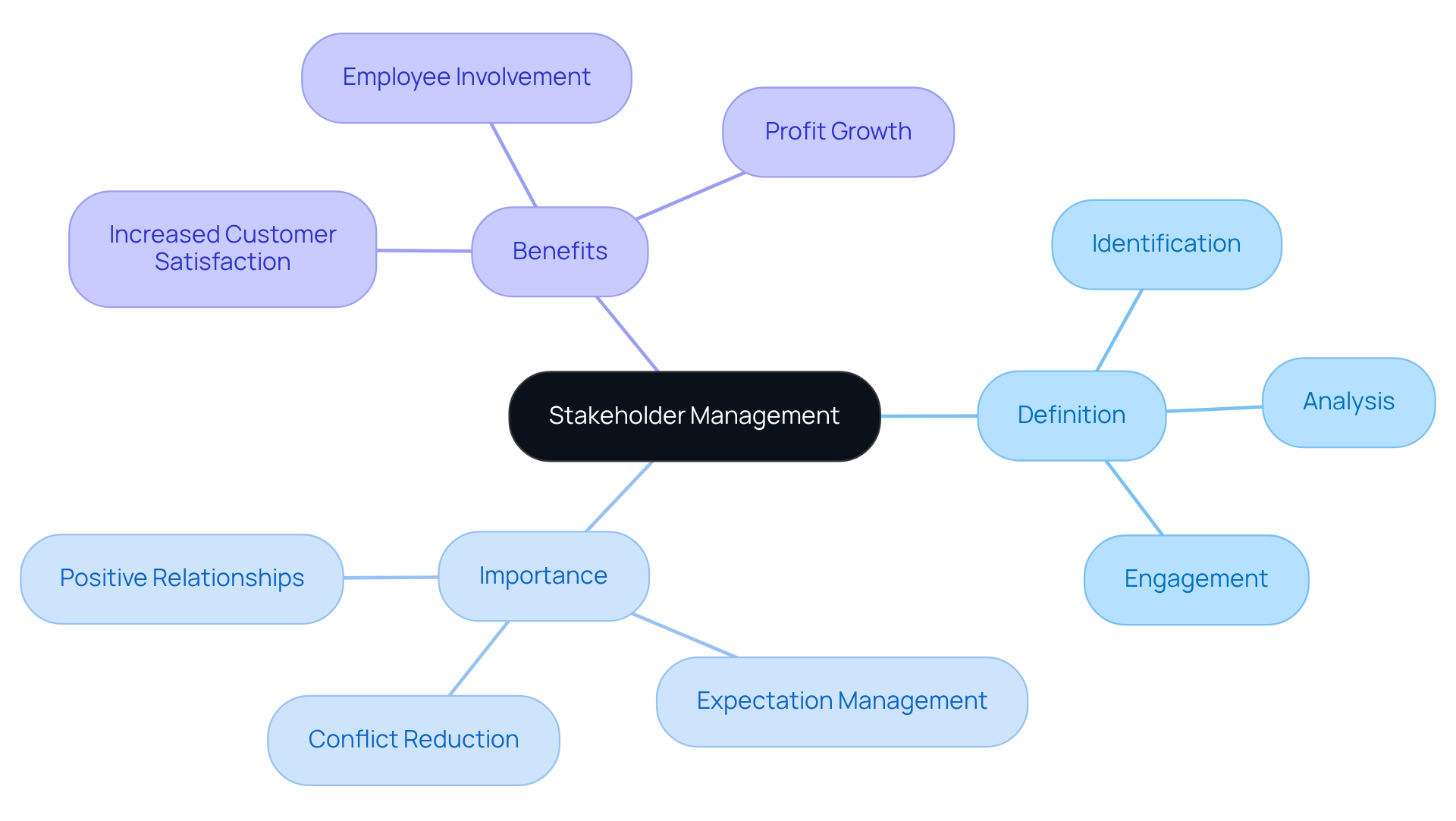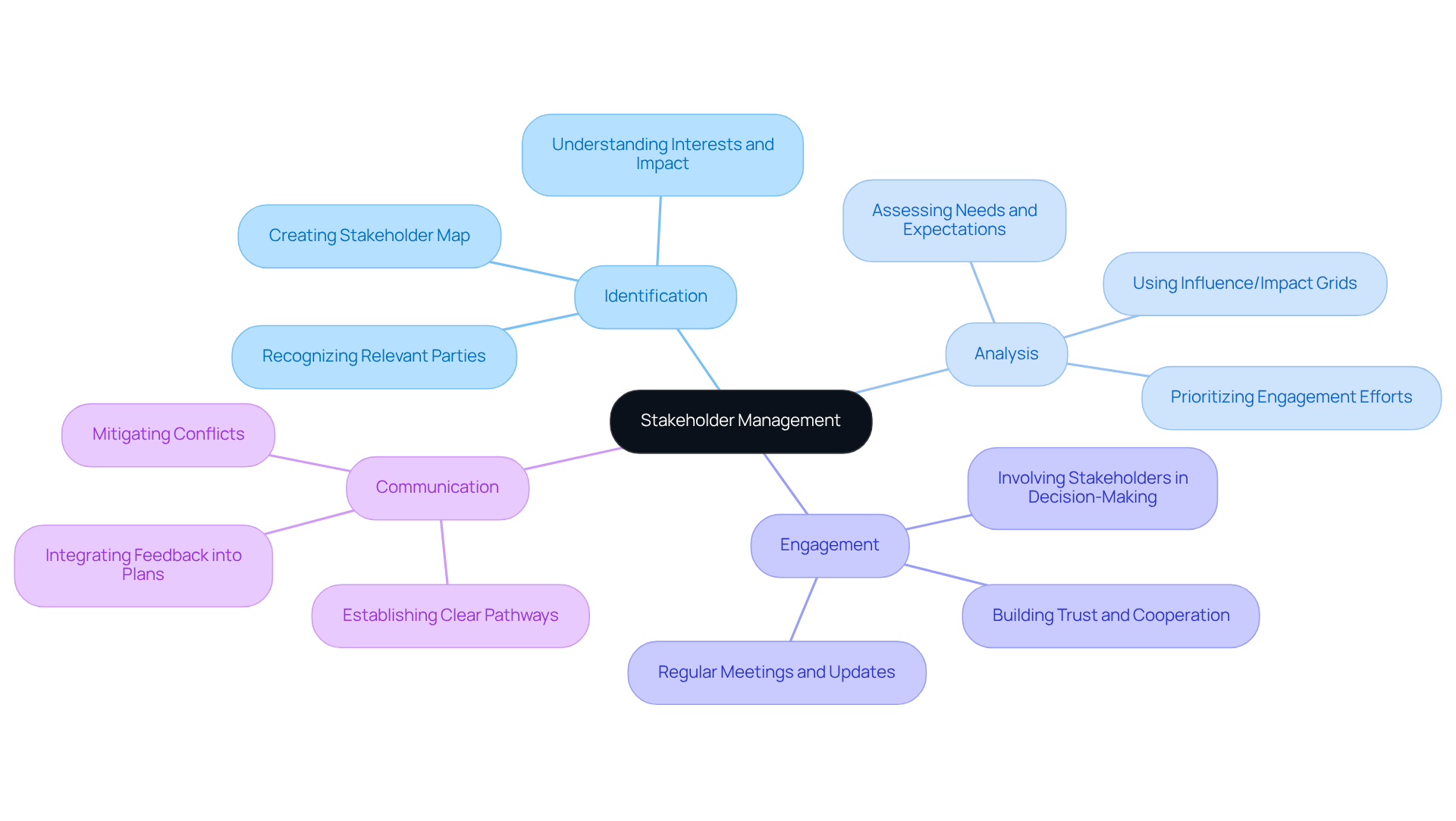Overview
Stakeholder management is the systematic identification, analysis, engagement, and communication with individuals or groups that have a vested interest in an organization. This process is crucial for achieving financial success. Effective stakeholder engagement not only enhances customer satisfaction and employee involvement but also leads to increased profits. These outcomes illustrate the tangible economic benefits of robust stakeholder management strategies.
Introduction
In today's interconnected business landscape, understanding the dynamics of stakeholder management is crucial, as the success of an organization hinges on its ability to engage effectively with various interested parties. This article explores the essential components of stakeholder management, emphasizing how strategic engagement can yield significant financial benefits, such as increased customer satisfaction and enhanced profitability. However, as businesses strive to align their goals with those of their stakeholders, a pressing challenge arises: how can organizations cultivate these relationships to not only meet expectations but also drive sustainable growth?
Define Stakeholder Management and Its Importance
What does stakeholder management involve? It includes the systematic identification, analysis, and engagement of individuals or groups with a vested interest in or influence on an entity or project. This critical process fosters positive relationships, manages expectations, and addresses the needs of involved parties, highlighting what does stakeholder management involve. Successful engagement with these stakeholders is intricately linked to economic achievement; it allows entities to align their goals with the interests of those involved, thereby reducing conflicts and promoting cooperation. Active involvement of parties enables companies to gather valuable insights, secure backing for initiatives, and ultimately enhance economic performance.
Studies indicate that organizations excelling in relationship management achieve up to 20% greater customer satisfaction and a 35% improvement in employee involvement, both of which contribute to enhanced financial outcomes. Moreover, companies prioritizing stakeholder engagement can see a 20% increase in profits, underscoring the tangible benefits of a robust stakeholder coordination strategy.
In conclusion, it is imperative for organizations to recognize the value of stakeholder oversight as a means to not only improve relationships but also drive economic success. By implementing effective engagement strategies, entities can position themselves for sustainable growth and profitability.

Trace the Evolution of Stakeholder Management
Stakeholder oversight has its roots in the 1930s, yet it was R. Edward Freeman's groundbreaking work in the 1980s that significantly popularized the concept and highlighted its strategic importance. Initially, the emphasis lay heavily on shareholders and financial returns. However, as the business landscape evolved, so too did the understanding of relationships with stakeholders, expanding to encompass a diverse array of groups, including employees, customers, suppliers, and the broader community. This shift signifies a growing recognition of the interconnectedness of various interests and the substantial impact these relationships have on long-term organizational success.
Today, effective management of stakeholders involves understanding what stakeholder management entails, as it is not merely an operational necessity but a cornerstone of corporate governance and strategic planning, directly influencing financial outcomes. For instance, studies indicate that organizations with engaged stakeholders report higher success rates, with nearly 70% of projects meeting their initial objectives. Furthermore, almost 90% of surveyed C-suite leaders believe there is a shift from shareholder to stakeholder capitalism, underscoring the current trend among executives.
Freeman's contributions to stakeholder theory have been pivotal in this transformation, as they help answer what stakeholder management involves by advocating for a comprehensive approach that considers the interests of all parties involved, thus promoting sustainable business practices. His assertion that 'the interest of shareholders relies on how effectively you interact with customers, suppliers, employees, and communities' encapsulates the essence of , emphasizing its critical role in achieving financial success.
Moreover, the Business Roundtable's 2019 letter, endorsed by 181 CEOs, redefined the mission of a corporation to include value for all stakeholders, further illustrating the formal acknowledgment of the importance of managing stakeholder interests in corporate governance.
Identify Key Components of Stakeholder Management
Successful oversight of involved parties requires understanding what does stakeholder management involve, which hinges on four essential elements: identification, analysis, engagement, and communication. The identification stage involves recognizing all relevant parties, both internal and external, and understanding their interests and impact on the project. This foundational step is crucial, as it lays the groundwork for a comprehensive interest holder map that informs management strategies.
In the analysis phase, organizations assess the needs and expectations of these parties to determine what does stakeholder management involve, enabling them to prioritize engagement efforts effectively. Techniques such as influence/impact grids and analysis matrices assist in categorizing involved parties based on their power and interest, guiding tailored engagement strategies.
Engagement strategies require actively involving interested parties in decision-making processes, highlighting what does stakeholder management involve to significantly enhance project outcomes. For instance, regular meetings and inviting key participants to discussions foster trust and cooperation, as evidenced by case studies showing that entities with engaged contributors are 50% more likely to achieve their objectives.
Our client engagement process commences with a thorough business review to align key stakeholders and gain a deeper understanding of the business situation beyond the numbers. This approach allows entities to identify underlying issues and collaboratively develop a plan to address weaknesses while enhancing strengths. Continuous monitoring of business performance is operationalized through real-time analytics, enabling organizations to track performance metrics and adjust strategies as necessary. This relationship-building process ensures that involved parties remain engaged and informed throughout .
Ultimately, communication is vital for understanding what does stakeholder management involve, as it keeps interested parties informed and ensures their feedback is integrated into project plans. Establishing clear communication pathways and defining expectations during project initiation meetings can mitigate potential conflicts and enhance participant satisfaction. By mastering these components, entities can forge strong relationships, foster collaboration, and ultimately improve their economic performance.

Examine Real-World Examples of Effective Stakeholder Management
Organizations are increasingly leveraging strategies to engage interested parties, resulting in . A prime example is Unilever's Sustainable Living Plan, which actively involves participants across its supply chain. This engagement not only enhances brand loyalty but also leads to a significant reduction in operational costs. Notably, sustainable brands have contributed over 60% to Unilever's overall sales increase, underscoring the impact of on growth.
Similarly, Starbucks has cultivated strong relationships with its suppliers and customers, which has fortified its reputation and driven impressive sales growth. These examples illustrate the critical role of participant management in fostering collaboration, mitigating risks, and enhancing financial performance. By prioritizing stakeholder engagement, organizations can better understand what stakeholder management involves, which helps them navigate challenges more effectively and capitalize on opportunities for sustainable growth.
In conclusion, the evidence is clear: what stakeholder management involves is essential for organizations aiming for long-term success.
Conclusion
Understanding stakeholder management is pivotal for organizations aiming for financial success. This strategic approach not only enhances relationships with involved parties but also aligns their interests with the organization's goals. By effectively engaging stakeholders, companies can mitigate conflicts, foster collaboration, and ultimately drive sustainable growth.
The article highlights several key aspects of stakeholder management, including its historical evolution, essential components, and real-world applications. From the foundational principles established by R. Edward Freeman to modern examples like Unilever and Starbucks, it is evident that prioritizing stakeholder engagement leads to tangible benefits such as increased customer satisfaction and improved financial performance. Organizations that embrace a comprehensive stakeholder management strategy are better positioned to navigate challenges and seize opportunities.
In light of these insights, it is crucial for organizations to recognize the importance of stakeholder management as a cornerstone of their strategic planning. By investing in effective engagement practices, businesses can not only enhance their economic outcomes but also contribute to a more sustainable and inclusive business environment. Embracing this holistic approach to stakeholder relations can pave the way for long-term success and resilience in an ever-evolving marketplace.
Frequently Asked Questions
What is stakeholder management?
Stakeholder management involves the systematic identification, analysis, and engagement of individuals or groups with a vested interest in or influence on an entity or project.
Why is stakeholder management important?
It is important because it fosters positive relationships, manages expectations, and addresses the needs of involved parties, which can lead to reduced conflicts and increased cooperation.
How does stakeholder engagement affect economic performance?
Successful engagement with stakeholders allows entities to align their goals with the interests of those involved, gathering valuable insights and securing backing for initiatives, ultimately enhancing economic performance.
What are the benefits of effective stakeholder management?
Organizations excelling in stakeholder management can achieve up to 20% greater customer satisfaction and a 35% improvement in employee involvement, contributing to enhanced financial outcomes.
How can stakeholder engagement impact a company's profits?
Companies that prioritize stakeholder engagement can see a 20% increase in profits, highlighting the tangible benefits of a robust stakeholder coordination strategy.
What should organizations recognize about stakeholder oversight?
Organizations should recognize the value of stakeholder oversight as a means to improve relationships and drive economic success, positioning themselves for sustainable growth and profitability.




